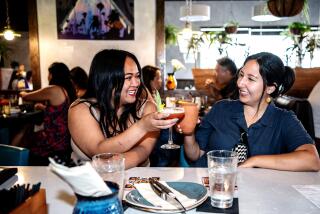Students Learning to Eat and Run : Collegians Adept at Cramming Meals Into Busy Schedules
Golden West College student Mari Lee begins breakfast promptly at 11:20 a.m. as she rushes to class with a Diet Coke in one hand and rice cakes in the other.
Dinner wonât be for another 10 hours, maybe a bowl of cereal and a banana during an evening homework break.
âIn between, I basically graze,â Lee said. âI might have a muffin in the afternoon and some fruit later. . . . It depends how busy I am.â
In the college cuisine of the 1990s, the customary breakfast-lunch-and-dinner routine has given way to portable sushi packs, deli sandwiches from vending machines and 10 p.m. cereal runs.
Pressured by heavy class loads, long commutes and demanding off-campus jobs, fewer college students have time for sit-down meals and are grabbing food when they can--often on the run.
Some nutritionists express alarm over the studentsâ reliance on fatty snacks over well-balance meals. University food managers, meanwhile, struggle to keep pace by opening dining areas late at night and preparing dishes that are both fast and healthy.
âStudents are in a quandary,â said Alan Moloney, director of food services at UC Irvine. âThey have so little time to eat. But they have been taught all about good nutrition and want to eat healthy foods.â
*
That is a far cry from the regimented college dining experience of a generation ago, when meat-and-potatoes meals like liver and onions and Salisbury steak were served cafeteria-style in cavernous eating halls.
âThirty years ago, you had one entree, one salad, one desert and one glass of milk,â said Eric Scandrett, a longtime college food-services manager who now heads Aramarkâs Chapman University operation. âIn those days, we even had a dress code for evening meals.â
Today, dining halls have given way to food courts that offer students dozens of eating choices from egg rolls and bagels to tacos and tofu. UCIâs facilities include Taco Bell and Togoâs restaurants, as well as espresso cafes, pizzerias, sushi bars and Mexican eateries.
The selection is vast, but the common denominator is speed.
âThey are looking for foods that donât take a long time to prepare,â Moloney said. âPeople donât want to stand in line waiting for their food.â
Many students at UCI, Cal State Fullerton and community colleges who drive to campus rarely have time for leisurely lunches. Often, commuter students try to compress their college schedules into two or three days a week, making time on those days even more of a luxury.
With students working or studying well into the night, colleges have detected a gradual decline in breakfast traffic. Some students say they are simply replacing an early morning meal with a post-dinner snack.
âI havenât had a pancake breakfast in years,â said Lee, 19, of Huntington Beach. âMost of my friends tend to have a light breakfast . . . or skip it.â
UCI is responding to the change by keeping some food areas open until 11 p.m. and extending breakfast hours at other facilities to serve late risers.
*
Students are also making a major dietary shift away from red meats. Chapman University estimates that about a quarter of its students donât eat meat, while a UCI study found that 35% of students surveyed call themselves vegetarians or âsemi-vegetarians.â
That trend also concerns dietitians. College students might know more about nutrition than their predecessors, but that doesnât mean they always select healthy foods.
âA primary concern of students is time,â said Katie Johansen, a nutritionist at UCIâs Student Health Center. âWhen they get stressed, their priority is not on eating. They tend to grab what is convenient.â
Johansen said many students end up eating fast food because they donât have the time or the knowledge to make healthy meals at home. âMany donât possess the most rudimentary food preparation skills,â she said.
Johansen and other experts insist that students can find healthy options, however, with a little effort. She suggests packing fruit from a snack during the day and seeking out salads and low-fat meals at the food court.
âItâs just about making a conscious decision to eat nutrient-dense foods,â she said.
âItâs like choosing to eat a banana over a cookie.â
More to Read
Sign up for Essential California
The most important California stories and recommendations in your inbox every morning.
You may occasionally receive promotional content from the Los Angeles Times.











